World
CONTACTAbout UsCAREER OPPORTUNITIESADVERTISE WITH USPRIVACY POLICYPRIVACY PREFERENCESTERMS OF USELEGAL NOTICE
© 2025 Equal Entertainment LLC.
All Rights reserved
All Rights reserved
By continuing to use our site, you agree to our Privacy Policy and Terms of Use.
We need your help
Your support makes The Advocate's original LGBTQ+ reporting possible. Become a member today to help us continue this work.
Your support makes The Advocate's original LGBTQ+ reporting possible. Become a member today to help us continue this work.
Germany light and dark
The Brandeburg Gate
Berlin is indeed one of the gayest and most gay-friendly cities in the world and a must-see for any queer visitor to Germany. But also consider for your itinerary the rich history and old-world charm of Bremen and Hamburg. And for the stout of heart--and for a life-changing encounter with the harsh realities of Nazi Germany--there's also the Neuengamme concentration camp
Blond-haired, blue-eyed Frauleins have never really been my type. But when I was invited to join a group of gay journalists for a tour of three Germany cities in May, I jumped at the opportunity. So I overpacked a bag--with the cool and drizzly weather, I never needed the many pairs of shorts or 20-odd T-shirts I had packed--and headed for Hamburg, courtesy of the German Tourist Bureau.
DAY ONE-DEPARTURE
Since there were no direct flights to Hamburg, my first stop was Frankfurt, the largest airport in continental Europe, offering connections to nearly 300 cities around the world.
At the security checkpoint at the Los Angeles airport, I was body-searched by a butch airport security guard. I kinda liked it. Then I made my way to the gate. I saw a handsome European-looking man wheeling a double stroller with two gorgeous identical blond infants on the automatic walkway. Despite their radiant blondness, I hoped they weren't headed for Frankfurt as well. I scurried past them. Inevitably, as soon as I was comfortably seated in business class the twins reappeared. A coincidence? I think not. Just my lousy luck: The twins, "Maggie" and "Lily," were happily gurgling in the seat in front of me.
DAY TWO-FRANKFURT AND HAMBURG
Except for the smell of cigarette smoke that hits you the minute you get off the plane, the Frankfurt Airport is immaculate. They even have garbage receptacles divided for recycling (as do all the public spaces in Germany) and self-cleaning toilets. Even though I was now a stranger in a strange land, feeling rather small, a tiny speck of humanity in a great big world, I made my connection without a hitch.
I grabbed a cab to the Dorint Am Alten Wall, a five-star luxury hotel that opened in the fall of 2000. Although the brightly-lit lobby is a bit cold, with its video art wall and austere sofas, my contemporary accommodations were divine. After all, I am a modern girl who greatly appreciates modern amenities. Spotless in a stark gray and white motif, my room was large enough to have a small sitting area and desk as well as a wonderfully appointed queen-size bed. Having the TV and minibar built into the wall is a cool space-saving idea, even though I did spend half an hour searching for the remote, which was hiding in a drawer on the very same wall.
The large marble bathroom had a separate shower and gigantic tub. Both featured strong, sexy shower massagers, if you get my drift. There was a magnifying mirror (Wow! I really needed a tweezing) and a powerful hair-dryer that really worked. And although I had just seen it in a famous Hollywood producer's home and it looked really cool, the above-tabletop sink proved to be a bit messy.
Too bad I didn't bring a bathing suit. The hotel spa boasts one of the sexiest indoor pools I have ever seen. Oh, well.
By the time I finished unpacking, it was time for dinner: a yummy meal of sausage, cabbage, potatoes, and beer at a local pub around the corner. Then I slipped between the wonderfully high-thread count sheets and drifted off into a dreamless sleep.
Dorint Am Alten Wall Hamburg
Alter Wall 40
D-20457 Hamburg
Tel. +49 (0) 40-3 69 50-0
www.dorint.de/hamburg-city
DAY THREE--"CHRISTOPHER STREET HAMBURG"
After gorging myself on one of the best hotel breakfast buffets I have ever had, I met up with the other members of the group and headed out to see Hamburg's very own Gay Pride Parade. With New York setting the spirit for gay pride the world over, it is aptly called Christopher Street Hamburg.
Christopher Street Day in Hamburg
The streets were teeming with people. Suddenly the parade began. But there was something odd about it. There were no dykes on bikes. No sexy cowboys in leather chaps. Just some odd-looking folks in Bavarian costumes. Two girls with sheitels were dancing together. German lesbians, I assumed. I took a picture. Only then did we learn that what were seeing was the Portuguese Parade! How odd, on the very same day as gay pride. What if their paths crossed? What if there was some hideous international incident? But no worry. It lasted all of seven minutes.
Then the real parade began, with Hamburg's very own Dykes on Bikes. Although far smaller than in New York or Los Angeles, there was a wonderful array of floats and marchers. Strains of the gay international anthem, "I Am What I Am," filled the air. I caught sight of an exquisitely beautiful young German boy, who looked like he belonged in the cast of Queer as Folk, dancing rhythmically with his eyes closed on top of a float. Even though I was in Germany, I thought, when it comes to gay pride, we really are all the same.
Christopher Street Day
After the parade I walked to the festival and began to see what a lovely city Hamburg is. With so many trees, parks, and walking paths, it is the greenest city in Germany. The famous Alster Lake is right in the middle of Hamburg. From it flows the many canals and waterways that criss-cross the city, making it feel a bit like Amsterdam.
The festival was right next to the Town Hall in the city center alongside Little Alster Lake, making it wonderfully picturesque. There were plenty of booths selling beer and bratwurst. To eat one, you hold the naked little wiener around its middle with a strip of paper, then you dab it into a dollop of mustard on a paper plate. Bread is optional, on the side. The crowd at the festival was a relaxed group of straights and gays who seemed comfortable mingling together.
That evening we had dinner at the Best Western Hotel St. Raphael. While the buffet was dry, the rooms were interesting. Different designers have individually designed 15 of their 125 rooms. The Sayonara Room had a wonderfully inspired Japanese motif, but after a few complaints the hotel management chucked the tatami mats and put in a real bed.
Best Western Hotel St. Raphael
Adenauerallee 41
D-20097 Hamburg
Tel (0 40) 2 48-20-0
www.straphael-hamburg.bestwestern.de
Now, for those who can't keep up, I recommend a disco nap, because after dinner it was time to party! And as in most cosmopolitan cities, other than health-conscious L.A., nightlife in Hamburg starts late.
The party celebrating gay pride was held on the Cap San Diego, an enormous ship dry-docked in Hamburg's harbor. Originally built in the '60s, it was primarily used for transporting meat from Buenos Aires to Germany. Down below it was poetic irony. The huge hold that was once packed with raw meat was now crammed full with hunky, sweaty men. Later it was all hands on deck to watch a male stripper.
More than 3,000 people partied the night away, mostly men but enough gay girls to make this sister feel at home. I, of course, managed to flirt with the one straight girl on the boat--she was there every time I turned around. And it was a big boat. As soon as I made contact, up walked the boyfriend. Auf viedersehen!
By now it was like 2:30 in the morning--time to check out the lesbian scene. I taxied over to the all-girl party at a nearby hotel. As it is in many cities, there is no regular women's club in Hamburg. Like a floating crap game, the women's scene changes each week and moves to a new venue. But it needn't be a crap shoot when you decide to visit: Go to www.Hamburg-tourism.de for gay and lesbian venues.
After mistakenly spending an hour in a mixed club, I finally figured out the women were next door. Duh. Finally! There they were, a nice mix of butches and femmes all hanging out in a sort of indoor-outdoor alleyway that was lined with tables and benches. With some of the women chowing down on bratwurst sold at a little stand, it felt a little like a girls' school lunchroom. The alleyway led to the disco, where the music was retro, Chaka Khan singing "Ain't Nobody." I tried to get a quote from a really hot-looking blond, but she wasn't buying my "I'm a journalist here reporting on gay life in Germany" routine.
I did talk to a buxom, dark-haired Greek girl who spoke to me about her lover: "Thank God she's half Greek and not all German. I couldn't be with her if she was like these other potatoes," she said, referring to the German women around us. She explained to me, in her fiery Greek way, that she found the German people void of emotion.
And there it was. That thing I was feeling but unable to put my finger on. Not only did everyone seem somewhat "flat," they seemed really strict. Like, "This is the schedule, und ve vill shtick to it!" But don't let this attitude throw you. Many Germans have a wonderful sense of humor--they just don't show it outright. This might be a sweeping generalization, but if you sort of just look at it as an entire nation of people who cover their mouths with their hands when they laugh, you'll do just fine.
I toasted the Greek for her wisdom and made my way back to the hotel and crawled into bed as the sun began to rise.
DAY FOUR--HAMBURG
Our guided tour began with a visit to Hamburg's free port, the largest in Germany. But with all the construction that was going on you could barely see the water. Hafen City, as the area is now called, is a mammoth development project designed to expand the historical warehouse complex that currently exists. In years to come the area will be a commercial, cultural, residential, and leisure haven. Think New York's South Street Seaport, only bigger.
While Hamburg has retained a good deal of the old-world charm of the 17th century, it is a very modern European city. Sights and things to do include City Hall, which dates back to 1886; a stroll through the old city; many museums; Hamburg's world-famous fish market; theater; shopping; and nightlife.
The once-seedy St. Paulie area, famous for its strip clubs and sex shops, has transformed into a young, hip mecca of restaurants and nightclubs. Prostitution, however, is still legal here, as long as the hookers follow the rules, remain on their side of the street, and stay within the five-block radius where they are allowed to hawk their wares only at night. Cool.
The adjacent St. Georg area is where most of the gay clubs and cafes are. Stop by the cafe Genosa to get the "lay" of the land. Call me naive, but I was surprised to learn that many of these local clubs have dark houses, which is what they call back rooms where guys can go for anonymous sex.
For more information on sightseeing in Hamburg go to www.Hamburg-tourism.de.
When it comes to gay life, Hamburg is a progressive city. A little over six months ago a law was passed recognizing gay unions in Germany. As our conversation turned to politics I learned that Neuengamme, a Nazi concentration camp where over 56,000 people lost their lives, was located just outside of Hamburg. I had to see it.
NEUENGAMME CONCENTRATION CAMP
I was compelled. In a matter of minutes I found myself on a train heading for Neuengamme, which has been partially turned into a museum. I admit I was a little scared to take the trip alone. Once on the train I clutched my map, paying careful attention so as not to miss the stop where I would get off and catch a bus to the Nazi camp. I got off at Begendorf station, in a seemingly nondescript German suburb. After waiting a while and with no bus in sight I asked a taxi driver to take me to Neuengamme. We headed out of town and after driving for about 15 minutes on tree-lined country roads we made a sharp left, and there it was. At first all I saw were the large cement smokestacks. Crematories, I assumed. There was a roadblock in front of the main driveway, not allowing the cab to go any farther. There wasn't a soul in sight. At the information booth at the train station they'd said the museum was open until 6 o'clock. It was almost 5.
I had no idea if I would be stranded there, but I let the cab go anyway. I got out and just stood there feeling completely alone. The silence was eerie. Then a lone bird started singing. It seemed so loud. I wondered if the prisoners who had been here were ever aware of the birds singing. I wondered if the bird's ancestors had stood witness to what had happened here. I wondered if one of my ancestors had died here.
I made my way up the driveway, suddenly aware of my own breathing and the sound of my shoes on the dirt path. As I rounded a bend and got closer to the main building I could see the rows and rows of barracks behind it. Along the path, half covered in dirt, was mosaic lettering: WAWSAW, KIEW. Every few feet there was another. I wondered if they had always been there or if they were put there afterward. Then I saw AUSCHWITZ and I knew. My heart began to pound in my chest.
I hurried along and was relieved to find a man in the anteroom of the main building. He told me that I was free to look around the grounds as well as the museum, which closed at 6 o'clock. He gave me a map and showed me where the main road was and where the bus would leave at 6:10. He also showed me where the prison was, which is what part of Neunegamme became immediately after the war. (If there were gay prisoners at the camp, they might well have spent time in the prison after the war, since laws against homosexual acts continued to be enforced for a time in postwar Germany.)
Through photos, old footage, and memorabilia, the museum gave the camp's history. An old brick factory, it was re-built in 1938 by the prisoners themselves. Thousands of Soviet prisoners were brought there in 1941. In 1944, transports of Jewish prisoners from Hungary and Poland were brought there. Out of a total inmate population of 106,000, at least 56,000 perished there.
With little time left, I headed outside to see the rest of the camp. As soon as I got outdoors it began to rain. I put on a hat and pulled my lightweight denim jacket around me. Unsure, I followed the map to a desolate path that would hopefully lead me closer to the barracks. I could see them just beyond the barbed-wire fence on my left. I couldn't see the end of the path. The ground was getting muddy.
I hurried along and finally came to a crossroad. There was a house. In front a sign read "Commandant's House." But I couldn't find it on the map, which was now beginning to run in the rain. I didn't know whether I should go left or right. In the distance I could see the cement walls of the prison and was able to faintly hear the men in the yard. I was worried about the time, that the museum would close and I would miss the bus. I was really scared and felt completely alone.
I was much relieved when I finally found my way to the bus stop on the main road and saw the bus coming.
While I saw very little of the camp itself, it wasn't until I got to the Jewish Museum in Berlin that I was able to fully appreciate and comprehend the extent of the emotional experience I had at Neuengamme.
In the Jewish Museum, there is a memorial called the Holocaust Tower. Made of bare concrete, it remains cool and damp even in summer. There is one single very high thin slit of a window to the outside world. Dim light falls inside, and while the faint noise from the street is audible, the world outside is completely out of reach. It evokes the naked isolation and emptiness experienced by concentration camp victims. I understood completely.
When I returned to our hotel in Hamburg I was drained. I have to admit at dinner that night--at a fabulous Asian-inspired restaurant in the Steigenberg Hof Hotel called Bistro Am Fleet--I was happy to see an extensive cocktail menu. Even though I was dying to order the absinthe, I knew two cosmopolitans would do the trick.
DAY FIVE--BREMEN BOUND
We took the train to Bremen--a short one-hour trip that I wished was longer, as I was thoroughly happy to be sitting down, not to mention enjoying the numbing relaxation brought on by the train's movement.
Our accommodations were at the Best Western Bremen, a comfortable and conveniently located hotel right across the street from the station. We dropped our bags and went off to see the sights of this quaint little fairy-tale town.
Our tour guide for the afternoon was a cherubic, balding middle-aged gay man who wore a bow tie and had a great laugh that burst out of him every now and then. (Of course, when that happened he covered his mouth with his hand.) He took great pride in taking us through the charming city of Bremen.
For some reason, the town is inexplicably linked to a Grimm Brothers fairy tale about the town's animal musicians. A bronze statue of the donkey, dog, cat, and rooster is prominently displayed in the town square. I am sorry to say that although I tried to understand the story and asked on several occasions, I still don't get it.
What I did get is that although Bremen is home to a good deal of aerospace research and technological advances, it is a cultural haven and retains a good deal of charm.
Our walking tour included the quaint bakeries and chocolate shops that line the streets, the colorful market square, and a tour of the old city and the Ratskellar wine cellar, which dates back to 1404. Bremen is the second-oldest republic in Europe after Vienna; art and culture surround you there.
That afternoon we visited the Rat and Tat Center, Bremen's own gay and lesbian center, whose primary function is counseling and support. This was one serious affair--trust me, there would be no performances by Margarette Cho any time soon. The somber four-story building that houses the center was purchased with money left by a gay benefactor and is financed in part by the state.
Neither of the two women we met with--psychologist Annette Mattfield and gay rights activist Sabina Michaelis--spoke English, so it was necessary to have our host from the German National Tourist Bureau translate the very serious discussion that took place. With their severe haircuts and masculine demeanor, they seemed a throwback to lesbians of days gone by. Although they seemed to be saying Bremen was a city that held little or no discrimination towards gays, I wondered why they seemed so damned serious. I think they were as happy to see us go as I was to leave. I went shopping immediately.
Dinner that night was at Aioli, a fun and yummy tapas restaurant in the old part of the city. I drank Beck's. After all, Bremen is where they make it.
Afterward we poked our heads into a few local gay bars. But we were full and they were empty. Then again, it was a drizzly Monday night in Bremen--who'd be out? Not us.
For more gay information on Bremen go to: www.bremen.gay-web.de or www.bremen-tourism.de
Best Western Hotel Zur Post:
www.bestwestern.de
DAY 6-BONJOUR BERLIN!
The train ride to Berlin took three and a half hours, with one change, but no matter. On the ultra-slick, super-deluxe high-speed I.C.E. train, time flew by. And to help get us in the mood I popped a DVD into my portable player. It doesn't get much gayer than heading to Berlin while watching Hedwig and the Angry Inch. Ah, Berlin. Known for its decadent nightlife of the '20s, like the world-famous Eldorado Schoeneberg, favored by Marlene Dietrich and Christopher Isherwood.
With the fall of the Berlin Wall on November 9, 1989--the same night the gay East German film Coming Out premiered nearby--Berlin set about the enormous task of reuniting and rebuilding the city. After more than 10 years of reunification, Berlin is booming. Berlin is the largest city in Germany--a vast and sprawling city, spread out like Los Angeles, but with the cosmopolitan edge of New York. With its liberal views on homosexuality, gay neighborhoods, and wide variety of gay nightlife, Berlin is truly one of the gayest cities in Europe. And with Berlin's new gay mayor, Klaus Wowereit, this year the rainbow flag will fly over City Hall during gay pride festivities.
We dropped our bags at our hotel, the Dorint Berlin, one of 14 new five-star hotels to be built since the fall of the Berlin Wall. While just as nice as its sister hotel in Hamburg, Berlin had more of a business feel to it. But as soon as we checked in we headed back out.
First stop: KaDeWe, Berlin's largest department store, selling everything from designer clothes to home furnishings. The most amazing part of the store is the epicurean gourmet shop on the sixth floor. With so many wonderful delicacies and several restaurants, it makes Macy's Cellar pale in comparison. Luncheon was served!
KaDeWe
Tzieinestarbe 21-24
Berlin
www.kadewe.de
By the way, be sure to stop in at one of Berlin's three tourist centers and pick up a welcome booklet, which will give you discounts to many shops, restaurants, attractions, museums, and more, as well as a free three-day pass for the buses and trains.
Berlin Tourist Info Center
Budapester Strabe 45
Tel. 0190-0-16 3 16
For other locations and more info go to www.berlin-tourism.de.
After lunch we boarded a double-decker bus to Checkpoint Charlie and the place where the Berlin wall once stood. It is amazing to see all the new shops and architecture that have sprung up in the area once known as No Man's Land. There, in the middle of a now-busy intersection, stands Checkpoint Charlie, the most well-known border crossing between East and West Berlin (originally, the American sector of occupied Berlin and the Russian sector, which became East Berlin) and the scene of many demonstrations.
The Maueruseum Haus Am Checkpoint Charlie is a must. The vast exhibition details the history of both parts of the divided city, from immediately after the war until the wall came down. Seeing the photographs, videos, and artifacts from August 13, 1961, when the wall went up, until November 9, 1989, is a shocking reminder that this devastating time of oppression happened not so very long ago.
Our next stop that day was Mann-O-Meter, Berlin's gay center, located in the very gay Schoenberg district. For the past 16 years it has provided counseling and a crisis hotline for the gay community. Far more festive then its Bremen counterpart, with its coffee shop, tables and chairs, Internet access, and magazine racks, it is a lively spot for men to find out what's happening in Berlin. I was a bit taken aback by the fact that, like a Hasidic wedding, the men's center and women's center were completely separated. Girls, get thee to Lesbenberatung in Kulmerstarsse to find out what's happening for chicks while you're there.
Mann-O-Meter
Bulowstrabe 106
10783 Berlin
Telefon 0 (049) 216- 80 08
For info on everything gay in Berlin go to www.out-in-berlin.com.
That evening we saw Berlin's theatrical extravaganza Wunderbar! How can I describe it? Well, it was like Cirque du Soleil. And a Vegas review. It was Aida, the Rockettes, and Mummenshantz all rolled into one. It was huge. There were more people on that stage then are employed by the entire Disney corporation. After the underwater sea scene, just prior to intermission, short of burning down the building I couldn't imagine what they could come up with for Act Two. But when I saw the aliens from outer space come down that Busby Berkeley staircase, I thought I would either pee my pants or wake up in my bed in L.A. realizing this entire trip had been nothing more then a dream. In short, it was the best laugh I have had in the theater in years. Too bad nobody else thought it was funny.
Wunderbar
Tickets (030) 23 26 23 26
FriedrichstadtPalast
FriedrichstaBe 107
10117 Berlin
www.friedrichstadtpalast.de
DAY 7--ICH BIN EIN BERLINER!
Our first stop this morning: the historical Reichstag, seat of the German Parliament. The glass cupola offers an incredible view of Berlin. With the devastation of the war and the rebuilding, it is a mixture of some of the newest architecture in Europe and old-world facades. From this vantage point our handsome guide, a young gay man named Markus, began lecturing on German history and politics. His socialist viewpoint was a fascinating eye-opener. He was an impassioned speaker--so much so that even though there were only five of us he insisted on using the microphone to continue his diatribe in our tiny little minivan.
Our next stop was the Schweues Museum (the Gay Museum). There Karl Heinz, whose passionate quest for exhibits and rare gay treasures keeps this museum alive, warmly greeted us. The museum itself consists of an exhibition area, archive, and library. Noted exhibits have included "The Persecution of Homosexual Men in Berlin, 1933-1945" and "Homage to Marlene Dietrich." Current exhibits are "Homage to Director Rainer Werner Fassbinder" and "The Literary Salon at Richard Schultz," the intimacy of which brought tears to my eyes. I felt so very comfortable and at home here, more so then anywhere we had visited so far. The gay museum is a must-see for the gay tourist in Berlin.
Schwules Museum
Mehringdamm 61, D-10961 Berlin
tel. 49 (0) 30 6959 9050
www.SchwulesMuseum.de
Although there are so many museums and cultural events in Berlin, I spent the rest of the afternoon at the world-famous Jewish Museum, an architecturally distinct building housing an exhibit of Jewish history from 800 A.D. to the present day.
For more information on sightseeing and museums go to: www.berlin-tourism.de.
That night our gay farewell to Berlin was at Rose's Bar, a campy hangout for gay men and women with red faux fur lining the walls, Chinese lanterns, and what appeared to be Valentine's Day decorations. We drank beer and laughed. Even our staunch tour guide Markus let his hair down and allowed himself to be gay in Berlin.
Don't worry, they love gay people in Germany.
For more information go to: www.visits-to-germany.com.
From our Sponsors
Most Popular
Bizarre Epstein files reference to Trump, Putin, and oral sex with ‘Bubba’ draws scrutiny in Congress
November 14 2025 4:08 PM
True
Jeffrey Epstein’s brother says the ‘Bubba’ mentioned in Trump oral sex email is not Bill Clinton
November 16 2025 9:15 AM
True
Gay makeup artist Andry Hernández Romero describes horrific sexual & physical abuse at CECOT in El Salvador
July 24 2025 10:11 AM
True
Watch Now: Pride Today
Latest Stories
Democratic officials sue RFK Jr. over attempt to limit gender-affirming care for trans youth
December 24 2025 4:30 PM
Heated Rivalry season 2: Everything we know so far
December 24 2025 3:30 PM
Lillian Bonsignore will be first out gay Fire Department of New York commissioner
December 23 2025 6:21 PM
The HIV response on a cliff-edge: advocacy must drive urgent action to end the epidemic
December 23 2025 2:23 PM
CECOT story pulled by Bari Weiss gets viewed anyway thanks to Canadian streaming service
December 23 2025 2:05 PM
Burkina Faso issues first sentence for 'homosexuality and related practices'
December 23 2025 2:02 PM
Transgender NSA employee files discrimination lawsuit against Trump administration
December 23 2025 12:03 PM
Billy Porter is set to make a 'full recovery' from sepsis
December 23 2025 11:54 AM
Soccer stars Rafaelle Souza and Halie Mace are engaged & the video is so adorable
December 23 2025 10:52 AM
What is 'hopecore' and how can it make life better for LGBTQ+ people?
December 23 2025 10:00 AM
Santa Speedo Run 2025: See 51 naughty pics of the festive fundraiser
December 23 2025 6:00 AM
Instructor who gave U of Oklahoma student a zero on anti-trans paper removed from teaching
December 22 2025 9:36 PM
All about the infamous CECOT prison — on which CBS's Bari Weiss pulled a story
December 22 2025 7:27 PM
Chest binder vendors respond to 'absurd' FDA warning letter: 'Clearly discrimination'
December 22 2025 3:16 PM
Gay NYC Council member Erik Bottcher drops U.S. House bid, will run for state Senate instead
December 22 2025 2:03 PM
Massachusetts removes rule requiring foster parents to support LGBTQ+ youth
December 22 2025 12:55 PM
Dave Chappelle defends Saudia Arabia set: Trans jokes 'went over very well'
December 22 2025 12:33 PM
Texas judge who refused to officiate same-sex weddings sues to overturn marriage equality
December 22 2025 11:41 AM
Trending stories
Recommended Stories for You






























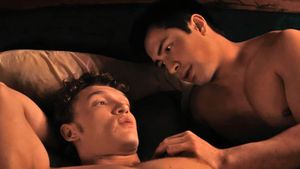
















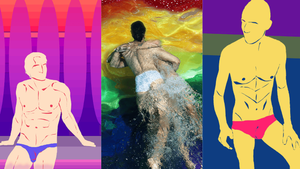




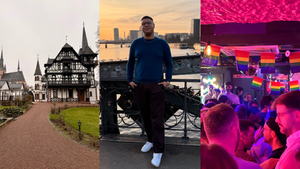






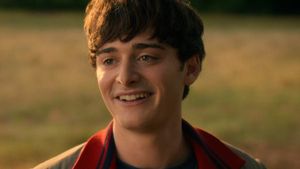
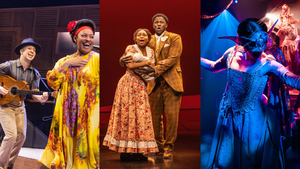
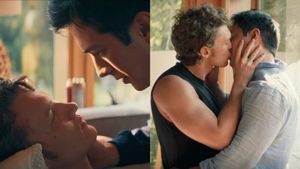






Charlie Kirk DID say stoning gay people was the 'perfect law' — and these other heinous quotes